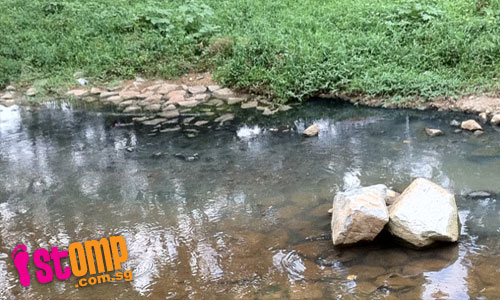
This canal in Bishan Park stinks, says STOMPer Tan. The STOMPer thinks that sewage is being discharged into the canal.
He said in an email (June 17):
"Sewage is being discharged into Bishan canal , stinking up and polluting our drinking water.
"Not sure what is the source, but it may be some food processing factory or restaurant along Sembawang hill
"Please check the discharge into Bishan canal, I think it is sewage water as the canal stinks.
"Please catch the culprit who is discharging sewage into the reservoir .
"NEA please do something good for your citizens, you are drinking the water as well."
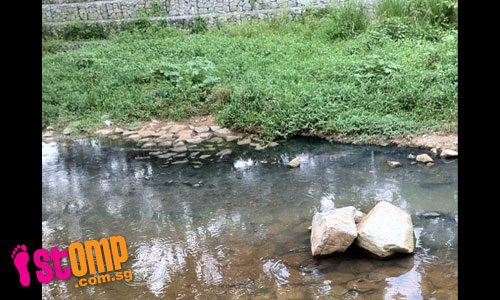

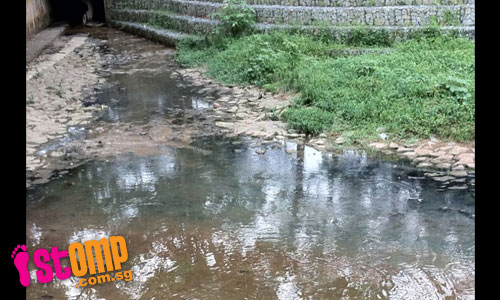
It's very difficult to tell if pollution is actually taking place, without locating an actual spot where sewage or other pollutants are being discharged into the water. It's just as likely that this is just decomposition of organic matter in the canal.
This concrete canal is undergoing the process of being transformed into a more natural-looking meandering river, as part of the Active, Beautiful, Clean (ABC) Waters Programme. Eventually, as part of the upper Kallang River, this river will be connected to the Marina Reservoir.
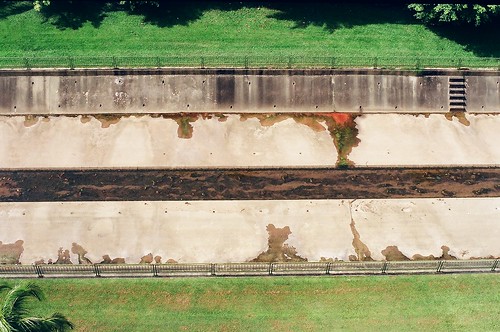
The old canal that ran alongside Bishan Park, 2008;
(Photo by ngrxt)
In some sense, this signals a backpedaling from the previous praactice of concretising all rivers and streams in the belief that this would prevent erosion of riverbanks. Now it seems that bioengineering is the latest buzzword, integrating vegetation with more traditional methods to not just reduce erosion and flooding, but also to provide water filtration and increase aesthetic value of our waterways. Not to mention that it helps create habitats for a variety of aquatic organisms. It helps that with the creation of the Marina Reservoir, there is now greater emphasis on improving the cleanliness of our waterways, and reminding people that the litter they thoughtlessly toss does often eventually end up in the reservoirs from which we derive our drinking water.

Building the river, 2010;
(Photo by glutton)
As stated in the Executive Summary of the Master Plan for the Central Catchment:
Integrating water – Singapore's life blood – into the City in new and innovative ways, is the goal of ABC Waters Programme. Our challenge is to manage the water in such a way as to restore the waterways and create new waterscapes that enrich Singapore.
ABC Waters Master Plan for the Central Catchment takes a landscape and urban planning visualization approach along with an engineering approach. Our Plan takes a fresh and integrated look at possibilities. The ideas that we have developed suggest a possible future that we envision to bring nature and humanity in harmony.
To avert the risk of potential disaster of flooding, Singapore's waterways historically have been manipulated and controlled. In the past, engineers re-engineered streams and re-designed canals as man-made channels, so that the stormwater would flow smoothly with as little interruption as possible.
So precise engineering design took precedence to channel the water from the surrounding area to prevent flooding from becoming a problem.
And to that end, the engineering designs succeeded so much so that the developments, for the most part, turned their backs on the canals and waterways.
ABC Waters Programme aims to achieve more. PUB has decided to integrate waterways into the flow and character of their city. This will be only possible by taking an integrated view - a view that includes engineering, science, landscape design, the behavioral framework of urban design and also a commitment to community connection.
Our Master Plan approach is grounded in the belief that we need to create a new symbolism for, and building a strong relationship, to water. As a result of our urban systems as a whole, our Master Plan reflects the hydrological processes that can be designed with landscape, engineering and urban designs that re-establish a relationship with water – one that is Active, Beautiful and Clean.
The Master Plan is based on the re-establishment of a landscape whose aesthetic rests on three objectives. First, it is based on the ecological and engineering requirements. This is achieved by analysing the existing hydraulic system, commissioning a vitality network for Singapore and rethinking the hydraulic system. Second, it is grounded on the integration of design objectives where design becomes multi-faceted, public and experiential. Potential Projects were identified through systematic analyses and evaluation. Third, and most important of all is the fact of visibility – of revealing the processes of water - not concealing and separating it from daily life which this Masterplan aims to achieve.
"Life is where the Waters Flow"
The Design Principles listed for possible projects involving the Kallang River are:
- Reintroduce indigenous flora and fauna
(to bring aspects of the rainforest gradually into urban and suburban cityscape) - Design potential projects according to the thematic phasing of the river theme (youth-maturity-rebirth)
- Select plants in line with the master plan introduced by NParks
- Enhance recreational areas along the river in order to connect the people with the Kallang River
- Express river edge with design elements
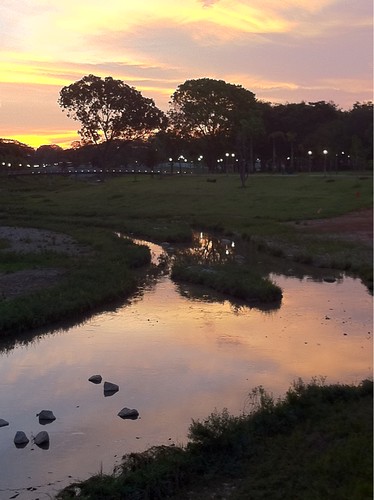
Kallang River in Bishan Park, 2011;
(Photo by sajid saiyed)
The Sub-Theme for the stretch along Bishan Park itself is known as "Birth of a River", and is described in the Master Plan as follows:
Bishan Park provides us with perfect space to express the youth of the river. This is symbolised by a wild and playful streaming and meandering of rivers. The river profile will be completely changed into a natural river with soft planted edges. Possibilities for safe interactions with the river will be created for the people such as kayaking and other watersports. Inflatable dams at strategic locations will provide deeper water and opportunities for a permanent water circulation are currently being studied. These will first, help to create a true river and secondly, help to improve water quality by filtering the water through a cleansing biotope or wetland.Sounds extremely interesting and exciting indeed.
Even certain parts of the existing lakes can be transformed into a wetland with the introduction of indigenous planting. This reintroduces species of rainforest in the park that create a strong connection to the original landscape of the area. Some areas will be more active with sports and active recreation possibilities, while other areas will be more quiet for wellness uses and passive recreation uses.